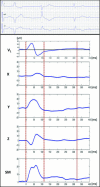P-wave morphology: underlying mechanisms and clinical implications
- PMID: 22816534
- PMCID: PMC6932587
- DOI: 10.1111/j.1542-474X.2012.00534.x
P-wave morphology: underlying mechanisms and clinical implications
Abstract
Increasing awareness of atrial fibrillation (AF) and its impact on public health revives interest in identification of noninvasive markers of predisposition to AF and ECG-based risk stratification. P-wave duration is generally accepted as the most reliable noninvasive marker of atrial conduction, and its prolongation has been associated with history of AF. However, patients with paroxysmal AF without structural heart disease may not have any impressive P-wave prolongation, thus suggesting that global conduction slowing is not an obligatory requirement for development of AF. P-wave morphology is therefore drawing increasing attention as it reflects the three-dimensional course of atrial depolarization propagation and detects local conduction disturbances. The factors that determine P-wave appearance include (1) the origin of the sinus rhythm that defines right atrial depolarization vector, (2) localization of left atrial breakthrough that defines left atrial depolarization vector, and (3) the shape and size of atrial chambers. However, it is often difficult to distinguish whether P-wave abnormalities are caused by atrial enlargement or interatrial conduction delay. Recent advances in endocardial mapping technologies have linked certain P-wave morphologies with interatrial conduction patterns and the function of major interatrial conduction routes. The value of P-wave morphology extends beyond cardiac arrhythmias associated with atrial conduction delay and can be used for prediction of clinical outcome of a wide range of cardiovascular disorders, including ischemic heart disease and congestive heart failure.
©2012, Wiley Periodicals, Inc.
Figures




References
-
- Platonov PG, Mitrofanova LB, Orshanskaya V, et al Structural abnormalities in atrial walls are associated with presence and persistency of atrial fibrillation but not with age. J Am Coll Cardiol 2011;58:2225–2232. - PubMed
-
- Stafford PJ, Turner I, Vincent R. Quantitative analysis of signal‐averaged P waves in idiopathic paroxysmal atrial fibrillation. Am J Cardiol 1991;68:751–755. - PubMed
-
- Steinberg JS, Zelenkofske S, Wong SC, et al Value of the P‐wave signal‐averaged ECG for predicting atrial fibrillation after cardiac surgery. Circulation 1993;88:2618–2622. - PubMed
-
- Yasushi A, Fukutami M, Yamada T, et al Prediction of transition to chronic atrial fibrillation in patients with paroxysmal atrial fibrillation by signal‐averaged electrocardiography. Prospective study. Circulation 1997;96:2612–2616. - PubMed
Publication types
MeSH terms
LinkOut - more resources
Full Text Sources
Medical

